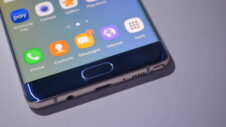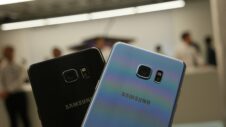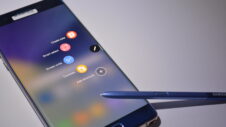It's Galaxy Note season, and with a new arrival soon to emerge, there's the usual discussion about whether or not the Galaxy Note (in this case, the Galaxy Note 7) is worth the financial investment from consumers. Everything in life is about perspective, but in some cases, a given perspective goes too far: it goes from saying that “the Galaxy Note 7 is not for me” to “the Galaxy Note 7 isn't for anyone,” “it's a device that isn't worth the money,” and so on.
I'm all for the idea that everyone has likes and dislikes, everyone has priorities when making purchases, and that some manufacturer priorities are not appreciated by everyone (though manufacturer preferences, like consumer preferences, should be respected). Despite the fact that you may not find a Da Vinci or a Rembrandt painting educational or insightful doesn't mean that it isn't insightful or that a lot of work didn't go into crafting it.
It's easy to see a bunch of lines, colors, and odd shapes when looking at a painting, but it's an exaggeration to say that the painting is “no big deal” and “nothing innovative” when one doesn't understand what the painter or artist has gone through to create the painting or the drawing. It presumes too much to just write off the artist because he or she hasn't drastically transformed the painting to something completely different.
And that's where we find ourselves with Samsung and the Galaxy Note 7. The new claim against the upcoming device is that it lacks innovation, with a “pointless” iris scanner and features that we've already seen on the Galaxy S7 edge, and the same Galaxy S7 edge SoC will make its way into the Galaxy Note 7 — yet another sign that Samsung is dropping the ball in the eyes of some. “Samsung is getting lazy” is the new chant.
There's respect to be had for the claim, but the claim itself is, to use a statement that goes against the curved design of this year's Galaxy Note 7, “flat wrong.”
The Galaxy Note 7 should be compared to the Galaxy Note 5, not the Galaxy S7 edge
Here's a thought: the Galaxy Note 7 should be compared to the Galaxy Note 5, its proper predecessor, not the Galaxy S7 edge. The Galaxy Note 7 will have a curved design that it's not borrowing from the S7 edge, but instead, the Note Edge that was announced alongside of the Galaxy Note 4 back in 2014. If anything, Samsung brought the curved design from the Note over to the S line in the Galaxy S6 edge in 2015, so the Galaxy S7 edge shouldn't even enter the equation when talking about the Note's curved design.
The Galaxy Note 7 can't be “a bigger Galaxy S7 edge with an S Pen” because it isn't borrowing its design language from the S7 edge, but instead, the Note Edge (with some tweaks). The Note Edge was the start of Samsung's curved revolution. It's fine that the curved display was too futuristic for some when it was announced two years ago: great ideas are usually ahead of their time, anyway, and are embraced later. This is what we see happening with the Galaxy S6 edge and Galaxy S7 edge.
The Galaxy S7 edge, if anything, has borrowed its design from the Galaxy S6 edge — which borrowed its design from the Galaxy Note Edge. That's where the curved revolution started, and that's where the discussion should begin. Placing the Galaxy S7 edge in the equation sounds to me like “card-stacking” at its finest.
The Galaxy Note and S lines are two different products for two different customers
It goes without saying, though current circumstances merit saying it, that the S line and Note lines are two different products for two different customers. The S Pen is more than just hardware: Samsung has integrated it with the Korean giant's own software that lets you draw, sign documents, write off-screen, and so on – activities that are impossible to do on the company's Galaxy S phones.
Those who are compare the two are not comparing oranges to oranges, but oranges to some other fruit (your choice here). If one wants to examine Samsung's innovation properly, he or she should compare S phones to S phones and Notes to Notes. Compare the Galaxy S6 edge and Galaxy S7 edge, for example, and the Galaxy S6 to the Galaxy S7 (or vice versa), but comparing two different phones in two different product lines is a way of watering down the complex nature of both phones for the sake of creating a straw man fallacy.
Sure, the Galaxy Note 7 and Galaxy S7 edge will have some features in common, but name any combination of S and Note phones over the last few years that haven't had features in common. When you look back at the history of phones, Samsung has always had features on one line it brought to the other. Why? Because those features are standard for the year in which they arrive and the R&D Samsung has done, not as a measure of laziness. I won't bore you with details of other manufacturers in the high-end market that have done the same exact thing with their phone lines, such as the whole Moto X and Droid Turbo series, or the HTC One M series and the HTC One A series, or LG's own smartphones.
The Galaxy Note 7 brings something new to the table, above the Galaxy S7 edge
As I've stated above, the Galaxy S7 edge shouldn’t be in the same discussion as the Galaxy Note 7 because the two phones are different in intention, but beyond this, the critics who say Samsung has gotten lazy in innovation are overlooking one thing: the Galaxy Note 7 will have new specs that you won't find on the Galaxy S7 edge. Where's the Galaxy S7 edge's USB-C port or iris scanner? Funny, but the S7 edge didn't get either of those. And that doesn't even include the S Pen and the new software features Samsung will bring – features that won't ever appear on the Galaxy S7 or Galaxy S7 edge.
The USB Type-C Samsung incorporates will have faster charging speeds than what we see on the market currently, and if fingerprint scanners have been said to “have potential,” then the same can be said of the iris scanner – even if the critics say it's pointless.
Where's the Galaxy S7 edge's 64GB variant? That never arrived to the US, with 32GB being the maximum amount of internal storage available for the US market. Just ask those you know whether or not they own a 64GB Galaxy S7 edge. You won't find many because only the Galaxy Note 7 (not the S7 edge) will be graced with 64GB as the base storage variant in Samsung's phone lineup.
Critics simply don't understand the Galaxy Note series
I've given in some long detail the firsts that the Galaxy Note 7 will accomplish for the Note lineup, but I think it's safe to say that the critics make these claims about the Galaxy Note 7 being “a bigger Galaxy S7 edge with an S Pen” because they misunderstand it completely. The Galaxy Note line has always been committed to the integration of the S Pen with its software features, letting you do things that can't be duplicated on the Galaxy S lineup. And those who buy the Galaxy Note don't buy it for a larger screen or a bigger battery, but for the S Pen.
It's called “Galaxy Note” for a reason: because it lets you jot down notes, sign documents, and do any form of writing you need done, right from the display. I sure wish other Android OEMs would understand that you cannot name a device “Note” without giving a stylus for note-taking abilities (here's looking at you Xiaomi, with your Redmi Note, or Lenovo with your K5 Note that lacks stylus integration altogether).
And this is the biggest misunderstanding of the critics: the Galaxy Note lets you “note,” but the Galaxy Note 7 will do everything the Galaxy Note 5 could do and then some. The Galaxy Note line has more capabilities than the S line has ever had, so it's misguided to claim that the Galaxy Note 7 is nothing more than an S7 edge with an S Pen.
The comparison is only valid for oranges to oranges, or Galaxy Note 7 to Galaxy Note 5
When comparing the financial progress of any smartphone maker, including Samsung, it's common practice to measure the company's performance in say, Q2 2016, for example, with the company's same earnings in the same quarter one year earlier (Q2 2015). The purpose of this financial comparison to give an idea of the company's performance is to take into account that companies often profit well in certain seasons or quarters but then either go back to having high sales or plummet terribly.
The same can be said for comparing “oranges to oranges.” In the matter at hand, the only valid comparison for the Galaxy Note 7 is the Galaxy Note 5, not the Galaxy S7 edge or the Galaxy S7. Those phones were the standard annual upgrade for the Galaxy S6 and Galaxy S6 edge, not the Galaxy Note lineup. And, since the Galaxy Note is always announced near the end of the year, Galaxy Note 5 users who've been waiting for their annual upgrade get to have their new device that packs the technology of the Galaxy S line with new S Pen features that put the Galaxy Note 7 above the best of the Galaxy S line.
In other words, the Galaxy Note 7 is a 2016 upgrade from the 2015 Galaxy Note 5, not an upgrade from the four-month-old Galaxy S7 edge.
Conclusion
Some things should not be said more than once, but sometimes they bear repeating because it seems as if some critics just don't understand the Note lineup, a series that has been on the market since 2011.
The critics who believe Samsung is getting lazy on innovation seem to miss the evidence, so let's put it here: 1) Samsung's dual camera modules are being purchased by Chinese OEMs, along with the Korean giant's dual-edge curved displays. Additionally, companies like Meizu have been buying Samsung's processors, and Samsung's LPDDR4 RAM is an industry standard: even in the LG G5, the Galaxy S7 and S7 edge's flagship rival, you'll find that the LG phone bears Samsung's LPDDR4 RAM. HTC's 10 bears a Samsung front camera sensor (and this isn't the first time HTC has gone with Samsung's front camera sensors).
Samsung's Exynos 7420 octa-core SoC found in the Galaxy S6, S6 edge, S6 edge+, and Galaxy Note 5 swept the market last year in performance and are even being used in VR headsets nowadays. As for this year's Exynos 8890 SoC, it's definitely still ahead of the game, so much so that Qualcomm decided to employ Samsung's low-power 14nm-FinFET process in producing the Snapdragon 820. This doesn't take into account the company's AMOLED panels which are being purchased by Android OEMs; heck, even Huawei and Google placed an AMOLED panel on the Nexus 6P in 2015, and OnePlus utilized a Samsung AMOLED panel in the OnePlus 3 this year. And for all the claims of an “iterative” design in the Galaxy S7 and Galaxy S7 edge, Samsung's phones are even winning their critics over. It's amazing how a few changes and tweaks can make something good even better.
No matter where you look, whether in battery life, cameras, SoCs, display tech, RAM, and even hardware in general, Samsung is leading the way in a number of areas and planting its feet firmly in others. They continue to lead the way in wireless charging, too, though you'd be hard-pressed to find other OEMs on the market investing in it (some have even removed it in their flagships). Samsung isn't perfect, but the company is anything but lazy.
And when you look at the Galaxy Note 7 for the first time, remind yourself that Samsung's dual-edge curved design will be the de facto standard that unsettles the conformity of the current box-form factor in smartphone design in the next few years (Samsung's GPUs will set a new industry standard, too). That's what Samsung means when it says that it offers “what's next now.”
Yes, looking at the Galaxy Note 7 is all about per-spec-tive – placing the specs in their proper context. In this case, comparing them to the Galaxy S7 and S7 edge make little sense whatsoever. When you compare the Galaxy Note 7 to the Galaxy Note 5, you'll see that micro-USB in the Galaxy Note 5 transforms into USB-C in the Galaxy Note 7, a 16MP camera with OIS and VDIS in the Galaxy Note 5 transforms into a 12MP back camera with OIS and Dual Pixel phase detection autofocus (PDAF) in the Galaxy Note 7, and a device that lacks water and dust resistance in the Galaxy Note 5 gets them with the next Galaxy.
The 3,000mAh battery in the Galaxy Note 5 transforms into a 3,500mAh battery in the Galaxy Note 7. It was said that the 3,000mAh battery in the Note 5 would take a turn for the worst in battery life as compared to the 3,220mAh battery in the Galaxy Note 4, but Samsung's 3,000mAh battery proved the critics wrong then, too. A Galaxy Note 5 that had UFS 2.0 only now gets to see UFS and microSD cards play nice together in the Galaxy Note 7, with hopes of adoptable storage coming in the near future to make the most of their re-integration.
The Galaxy Note 7 is anything but boring, but the constant claim that Samsung isn't innovating, when the evidence shows otherwise, is.







